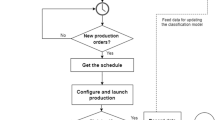Abstract
This paper presents an order scheduling heuristic to minimize the total collation delays and the makespan in high-throughput make-to-order manufacturing systems. Order collation delay is the completion time difference between the first and the last processed items within the same order. Large order collation delays contribute to a reduced throughput, non-recoverable productivity loss, or even system deadlocks. In manufacturing systems with high throughput, this scheduling problem becomes computationally expensive to solve because the number of orders is very large; thus, efficient constructive algorithms are needed. To minimize both objectives efficiently, this paper proposes a novel workload balance with single-item orders (WBSO) heuristic while considering machine flexibility. Through a comparison with (1) the non-dominated sorting genetic algorithm II (NSGA-II), (2) priority-based longest processing rule (LPT-P), (3) priority-based least total workload rule (LTW-P), and (4) multi-item orders first rule (MIOF), the effectiveness of the proposed method is evaluated. Experimental results for different scenarios indicate that the proposed WBSO heuristic provides 33% fewer collation delays and 6% more makespan on average when compared to the NSGA-II. The proposed method can work on both small and large problem sizes, and the results also show that for large size problems, the WBSO generates 74%, 89%, and 62% fewer collation delays on average than LPT-P, LTW-P, and MIOF rules respectively.








Similar content being viewed by others
Data Availability
The datasets analyzed during the current study are not publicly available due to the requirement of funder. Data are however available from the authors upon reasonable request and with permission of the funder.
Code Availability
The codes developed during the current study are not publicly available due to the requirement of funder. The codes are however available from the authors upon reasonable request and with permission of the funder.
References
Julien F, Magazine M (1990) Scheduling customer orders: an alternative production scheduling approach. Journal of Manufacturing and Operations Management 3(3):177–199
Wang B, Guan Z, Chen Y et al (2013) An assemble-to-order production planning with the integration of order scheduling and mixed-model sequencing. Front Mech Eng 8(2):137–145
Dauod H, Li D, Yoon SW et al (2018) Multi-objective optimization of the order scheduling problem in mail-order pharmacy automation systems. Int J Adv Manuf Technol 99(1):73–83
Li D, Yoon SW (2015) A novel fill-time window minimisation problem and adaptive parallel Tabu search algorithm in mail-order pharmacy automation system. Int J Prod Res 53(14):4189–4205
Mei K, Li D, Yoon SW et al (2016) Multi-objective optimization of collation delay and makespan in mail-order pharmacy automated distribution system. Int J Adv Manuf Technol 83(1):475–488
Yang J (2005) The complexity of customer order scheduling problems on parallel machines. Comput Oper Res 32(7):1921–1939
Leung JY, Li H, Pinedo M (2005) Order scheduling models: an overview. Multidisciplinary Scheduling: Theory and Applications. pp 37–53
Alharkan I, Saleh M, Ghaleb MA et al (2020) Tabu search and particle swarm optimization algorithms for two identical parallel machines scheduling problem with a single server. J King Saud Univ Eng Sci 32(5):330–338
Lin BM, Kononov AV (2007) Customer order scheduling to minimize the number of late jobs. Eur J Oper Res 183(2):944–948
Meng L, Zhang C, Shao X et al (2019) Mathematical modelling and optimisation of energy-conscious hybrid flow shop scheduling problem with unrelated parallel machines. Int J Prod Res 57(4):1119–1145
Sung CS, Yoon SH (1998) Minimizing total weighted completion time at a pre-assembly stage composed of two feeding machines. Int J Prod Econ 54(3):247–255
Leung JYT, Li H, Pinedo M (2008) Scheduling orders on either dedicated or flexible machines in parallel to minimize total weighted completion time. Ann Oper Res 159(1):107–123
Shi Z, Wang L, Liu P et al (2015) Minimizing completion time for order scheduling: formulation and heuristic algorithm. IEEE Trans Autom Sci Eng 14(4):1558–1569
Lee IS (2013) Minimizing total tardiness for the order scheduling problem. Int J Prod Econ 144(1):128–134
Leung JYT, Li H, Pinedo M (2007) Scheduling orders for multiple product types to minimize total weighted completion time. Discret Appl Math 155(8):945–970
Framinan JM, Perez-Gonzalez P (2017) New approximate algorithms for the customer order scheduling problem with total completion time objective. Comput Oper Res 78:181–192
Xu X, Ma Y, Zhou Z et al (2013) Customer order scheduling on unrelated parallel machines to minimize total completion time. IEEE Trans Autom Sci Eng 12(1):244–257
Choi YC, Kim YD, Bang JY (2010) Scheduling algorithms for an air conditioner manufacturing system composed of multiple parallel assembly lines. Int J Adv Manuf Technol 51(9):1225–1241
Guo Z, Wong WK, Li Z et al (2013) Modeling and pareto optimization of multi-objective order scheduling problems in production planning. Comput Oper Res 64(4):972–986
Belegundu AD, Chandrupatla TR (2019) Optimization concepts and applications in engineering. Cambridge University Press
Deb K, Pratap A, Agarwal S et al (2002) A fast and elitist multiobjective genetic algorithm: NSGA-II. IEEE Trans Evol Comput 6(2):182–197
Vairaktarakis GL, Cai X (2003) The value of processing flexibility in multipurpose machines. IIE Trans 35(8):763–774
Ahmadi E, Zandieh M, Farrokh M et al (2016) A multi objective optimization approach for flexible job shop scheduling problem under random machine breakdown by evolutionary algorithms. Comput Oper Res 73:56–66
Khader N, Lashier A, Yoon SW (2016) Pharmacy robotic dispensing and planogram analysis using association rule mining with prescription data. Expert Syst Appl 57:296–310
Acknowledgements
This study was supported by the Watson Institute of Systems Excellence (WISE) at Binghamton University and was partially supported by “Research Base Construction Fund Support Program” funded by Jeonbuk National University in 2022.
Author information
Authors and Affiliations
Contributions
HD did the conceptualization, data curation, formal analysis, investigation, methodology development, coding, result validation, and visualization and was a major contributor in writing the original manuscript. NC did the result validation and manuscript review and editing. DL did the data curation, result validation, and manuscript review and editing. JK did the data curation, resources providing, supervision, result validation, and manuscript review and editing. SY did the methodology development, project administration, supervision, and manuscript review and editing. DW did the conceptualization, methodology development, project administration, supervision, and manuscript review and editing. All authors read and approved the final manuscript.
Corresponding author
Ethics declarations
Ethical Approval
-
1.
This material is the authors’ own original work, which has not been previously published elsewhere.
-
2.
The paper is not currently being considered for publication elsewhere.
-
3.
The paper reflects the authors’ own research and analysis in a truthful and complete manner.
-
4.
The paper properly credits the meaningful contributions of co-authors and co-researchers.
-
5.
The results are appropriately placed in the context of prior and existing research.
-
6.
All sources used are properly disclosed (correct citation). Literally copying of text must be indicated as such by using quotation marks and giving proper reference.
-
7.
All authors have been personally and actively involved in substantial work leading to the paper, and will take public responsibility for its content.
Consent to Participate
Not applicable.
Consent for Publication
Not applicable.
Competing Interests
The authors declare no competing interests.
Additional information
Publisher's Note
Springer Nature remains neutral with regard to jurisdictional claims in published maps and institutional affiliations.
Rights and permissions
Springer Nature or its licensor (e.g. a society or other partner) holds exclusive rights to this article under a publishing agreement with the author(s) or other rightsholder(s); author self-archiving of the accepted manuscript version of this article is solely governed by the terms of such publishing agreement and applicable law.
About this article
Cite this article
Dauod, H., Cao, N., Li, D. et al. An Order Scheduling Heuristic to Minimize the Total Collation Delays and the Makespan in High-Throughput Make-to-Order Manufacturing Systems. Oper. Res. Forum 4, 49 (2023). https://doi.org/10.1007/s43069-023-00227-2
Received:
Accepted:
Published:
DOI: https://doi.org/10.1007/s43069-023-00227-2




